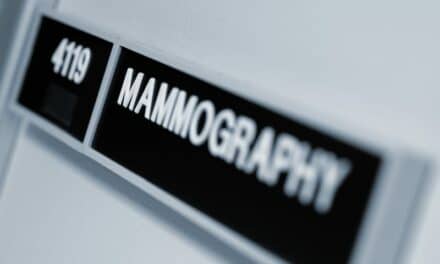Mammography is the examination of breasts with x-rays. Surprisingly, mammography has a history that dates back to the early 1900s. In 1913, Albert Salomon, MD, from the Surgical University of Berlin was the first to document the radiographic evidence of a tumored breast. Salomon used glass plates and early x-ray technology to create his images.
Due to poor image quality, advances in mammography were halted until the early 1950s. Using microcalifications, Raoul Leborgne, MD, realized the need for perfect technique when studying mammography. He noted four major points: the need for a low kilo voltage peak (kVp) technique, the need for collimation of the x-ray beam, the need for high-contrast images, and the need for tissue compression. In 1956, Robert Egan, MD, noted ways to achieve Leborgne’s equipment needs by optimizing the x-ray equipment, using specialized film processing, and implementing specialized training for mammography radiologists.

The Senographe had significant changes from a general x-ray machine. These changes included: a rotating tube stand—built for positioning; the x-ray tube was cooled with molybdenum and water; the x-ray tube exit window material was changed to beryllium and replaced the glass previously installed, allowing the low-energy photons to exit, which is crucial for mammography; the focal spot was reduced from 1.5 to 2.0 mm down to 0.7 mm; a dedicated control panel was created to allow low-dose selection by the operator; a variety of interchangeable cones were created for greater collimation; and a compression paddle was added to the tube stand.
Compression force has to fall within the range of 25 to 40 pounds. Keep in mind that the most common problems with compression is the cracking of the paddles and the force applied. When cracks start to develop on the paddles themselves, these cracks can show up on the processed x-ray film. If compression force starts to decrease, image quality can be affected. This can usually be adjusted by a potentiometer on the tube stand itself or on a PCB inside the machine’s generator.
Imaging Facts
kVp measures the force of electrons that hit the target and determines the x-ray’s penetration force. A low kVp generates longer wavelengths, which are best for imaging soft breast tissue. About 25 kVp is the norm for mammographic imaging if a grid is not being used. If a grid is in place, you can typically add 2 kVp for the technique. Ranges below 25 kVp will increase radiation dose, and ranges above 30 kVp will compromise image contrast.
Milli amperage seconds (mAs) is the current driven to the filament of the x-ray tube cathode. The mAs regulates the amount of electrons available to penetrate the target. Also, the mAs is variable, allowing the technologist to change settings during an exam to get the best possible image for that patient. Generally, the kVp is a set number and is not changed.
Automatic exposure control (AEC) is a circuit that monitors the x-rays that hit the image receptor under the film cassette and automatically stops the exposure at a preset value—known as photo-timing. When AEC is used, only the mAs value is changed to create a consistent film density throughout the image.
With the introduction of digital systems for mammography, we can expect some radical changes in equipment, techniques, and storage of the images. Digital systems have been shown to be better on younger patients and those with very dense breasts. There is some resistance to digital systems—mostly due to their price—but digital systems are coming and will replace most of the units presently in use within 5 years.
Xerography is a dry photographic or photocopying process in which a negative image (formed by a resinous powder on an electrically charged plate) is transferred to and thermally fixed as positive on paper or other copying surfaces. It was first introduced to the medical field in the 1960s with mammography, and it used two units: a conditioner and a processor. First, a photo-conducting, selenium-coated aluminum plate is electrically charged and placed in a cassette, which completes the conditioning process. After the cassette is exposed to an x-ray beam, a dormant transparent image is existent on the plate. The plate is then removed from the cassette and placed in the processor. The dormant image is now exposed to a blue powder of charged particles. The powdered image is then transferred onto a plastic sheet. When the plastic sheet is heated, the powder image becomes part of the plastic and is then visible.
Mammographic view boxes have specific light-output regulations for viewing the processed film. View box light intensity is measured in nit—this is a unit of visible-light intensity. One nit is equivalent to one candela per square meter, and a candela is equivalent to 1 candle power. A mammographic view box must obtain a minimum output strength of 3,000 nit. This value can be tested with a calibrated natural daylight meter.
Assuring Quality
Daily tests must be performed to assure the quality of the x-ray image generated on the film and of the processing unit of the film. Temperature readings of the developer and fixer must be checked daily and must fall within acceptable ranges, per the processor’s manufacturer. These values depend on the brand of developer and fixer being used, but they are generally between 33° and 35° centigrade. A phantom is an acrylic block used as a control and simulates a patient. This image is then processed, and the exported film is then tested with a densitometer. A densitometer is an instrument for determining optical or photographic density of film. The optical density of the center of the phantom image must be between 1.10 and 1.50 for films exposed at the kVp used by the facility. A sensitometer—an instrument for measuring the sensitivity of photographic material—is then used. A sensitometer will expose the film to a controlled light to be processed for later review. When the film is processed, it is then tested on the densitometer to determine the range of optical densities that provide optimal film contrast. When checked, these values must not exceed + or – 0.15 of the previously checked optical density with the phantom. These tests should be performed by the technologists, not the BMET.
David Harrington, PhD, is director of staff development and training at Technology in Medicine (TiM), Holliston, Mass, and is a member of 24×7’s editorial advisory board.
Carl Genereux is a TiM account manager at Marlborough Hospital, Marlborough, Mass.




